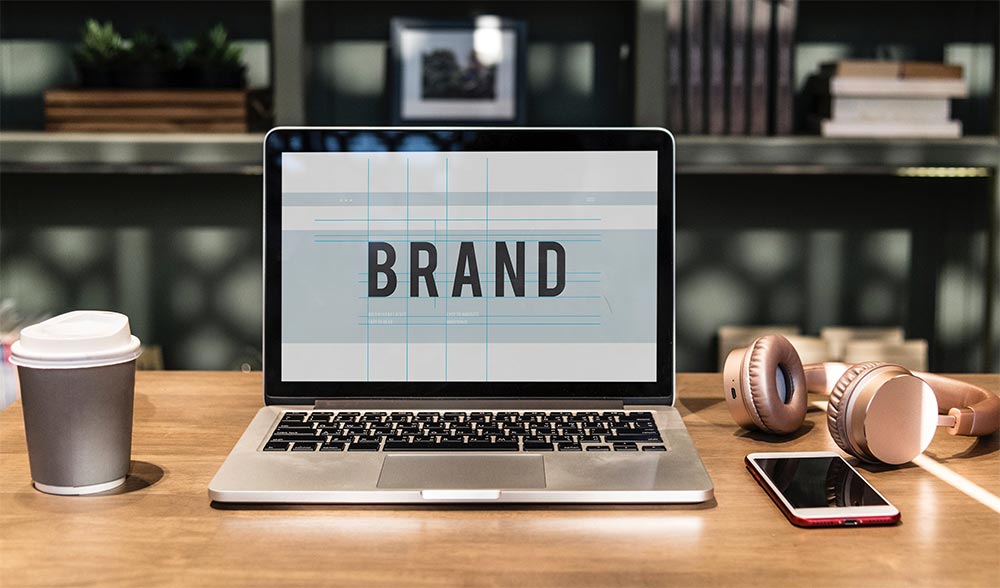
Are you building a new brand or refining your current brand? Once you understand how to work with branding and develop strong branding guidelines for your business, you will be well on your way to success as a company. The branding you create and develop is the summation of all the visual and language elements related to your company.
When people think of your brand, they think of your “branding elements.” These elements are the face of your company and include your logo design, color palette, iconography, patterns, visuals, and messaging. Company branding requires being visually and linguistically consistent when representing your brand. It should be easy for consumers to recall your brand identity, and, in turn, associate it with the qualities you’ve built your brand on.
Table of Contents
- What is Branding?
- Logo Design
- Brand Recognition
- Basing Branding Guidelines on a Style Guide
- What to Include in the Style Guide
- Branding Online
What is Branding?
Branding is the tried and true method of promoting your brand as a cohesive identity. Companies use branding to showcase who they are to their customers. When branding is done properly, customers have strong feelings about the brand. They trust the brand, identify with it, and feel it represents a part of themselves. When you focus on branding as a company, you are evoking feelings and generating a connection with your customers. In other words, you are focusing on building a relationship with them.
The Coca-Cola Company is an example of branding that works. Because the company consistently represents its brand using the same language and images, customers will inevitably start thinking of them whenever they see those images. People laughing and smiling with their soda cans, the taste of the drink, and the color red, are all popular images that come to mind. “Taste the Feeling,” their most recent slogan, may also come to mind. Coca-Cola definitely knows what their strengths are and what they are selling to consumers. Strong branding makes it easy for consumers to remember brands and increases the likelihood that they will purchase their products or services.
Logo Design
Why do logos mean so much to businesses? Logos are the primary way to instantly evoke a feeling within consumers. When customers see the Apple logo, they have a reaction. Their reaction is based on their relationship with the Apple brand. That is branding at its core. Branding is more than a logo — it’s about creating a connection between the brand and the consumer.
Your logo design is one way that you can connect with consumers. In fact, it is typically one of the first things that customers see when they learn more about your brand. You want your logo design to be a positive representation of your brand. You also want your logo design to convey the basics about who you are and what you do. You want to make sure that your logo entices customers to learn more about your brand.
Brand Recognition
Brand recognition is the result of branding. Marketing professionals follow branding guidelines in order to build recognition. If every piece of communication by a business follows branding guidelines, then customers will begin to build brand recognition for the brand. Seeing the brand’s logo or other branding materials will evoke mental images and feelings associated with the company. Branding is the reason these thoughts and feelings stay in the consumer’s mind and become intrinsic to the brand.
Basing Branding Guidelines on a Style Guide
It is vitally important that all of your branding guidelines be included in a professional style guide. A style guide is a comprehensive catalog that describes, in detail, your branding requirements. It includes your brand’s message, vision, target audience, overall personality, and core values.
Why is having a professional style guide so important? Too often companies think that they can reproduce the branding concepts across different departments and spanning multiple years without formal guidelines. They eventually make guesses as they create marketing and branding materials. This results in an inconsistent brand image and inconsistent branding, which is a sure-fire way to confuse consumers.
Now that you know what a style guide is and why it is so important, here are a few tips in terms of creating one. First, the style guide needs to be detailed. It needs to list your color palette, typography, imagery, logo, and voice. You will need to list specifics for each of these areas. The key to an effective style guide is to be as specific as possible. Creating a style guide sets a solid foundation that must be followed to ensure that your branding is universal.
Sound daunting? Start small. Begin with a single reference sheet and add to it. If you have a team, try breaking up parts of the document and passing it around for team input. You might not agree with everything that your team says, but you never know who might have a good idea for your branding document. You can always revise the information later (during the editing process), but you definitely want plenty of material to work with. You can then change/add items, and remove any inconsistencies before using it as your official style guide.
Make sure the style guide document is easily shareable so that every person who creates branding or marketing materials in the future can reference it. All materials ought to adhere to the style guide. If not, the materials should be revised. The style guide should also be shared with any third parties who you outsource to when building your brand.
What to Include in the Style Guide
One of the key pieces found within a style guide is your brand story. What is the meaning behind your brand and what is the message? Make sure each of the elements in your style guide refers back to your brand’s story.
When it comes to your logo design, it’s important to detail the proportions that can be used and to list the minimum size. If there are color or style variations of your logo, those need to be included as well (with clear guidelines about when each color or style variation of the logo can be used).
Your brand’s color palette is not merely the colors in your logo design, but also the colors that can be used in branded materials. You might include a few additional colors or color variations to create less of a monochrome feel. In the style guide, list the various codes for each color including HEX or RGB values as well as Pantone formulas (when applicable).
Typography might sound like an easy step, but you shouldn’t limit it to only the typography used in the logo. Include any alternative typography that might be used in promotional materials, as body text on a website, or even within an email campaign.
Branding Online
As you create online materials for your company, your branding needs to remain strong and recognizable. This begins when choosing the domain name for your business. Your domain URL needs to align with your brand name and should be easy to remember, type, and share.
Sharing content from other sources using branded links is another way to use branding online. When you find something interesting that you want to share with your customers, it’s best to use a vanity URL or custom link. This strips the identity of the article you are sharing and provides your name as part of the link to increase visibility for your brand. These links can also be used to shorten blog articles that you share via social media or email. These URLs serve as another touchpoint customers have with your brand.
Another aspect of branding online is the appearance of your social media pages. These pages should be easily identifiable as an extension of your brand. This means that they should feature your logo design and use your color palette. You should make sure that any messaging is in alignment with the editorial notes found in your style guide. The language, voice, tone, and word choices should all be representative of your brand.
Logo Coast offers logo design and branding services that help capture the mission statement behind your brand. Share your brand’s message with specific branding materials that clearly communicate your identity. Make your brand easily recognizable by your core demographic so they associate positive qualities with you. Branding is a necessary and vital part of any successful business. We work with companies of all sizes and would love to work with you.












